Help! My Dog Hates Baths
Q: How do I get my dog to stop biting when I try to give her a bath? It’s like she becomes a ferocious attack dog. – Jason S.
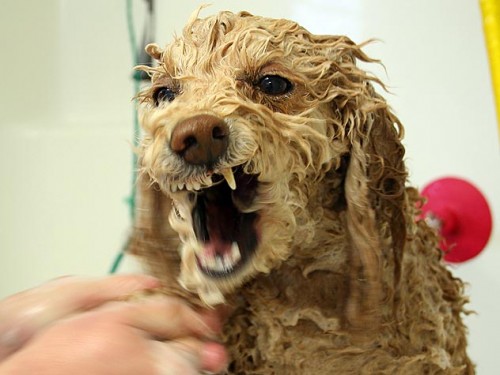
Practice having her in the tub, if that is her bathing spot, with no water running at first. Running water can be scary for dogs, especially with a high-pressure faucet.
Put down an inexpensive rubber bath mat so she doesn’t slip (slipping can add to her nervousness).
Have her on leash and have a helper gently hold her as you let her lick from a sterilized bone (such as those made by Gimborn) stuffed with a creamy food like cream cheese or peanut butter. Gently brush her as she works on the bone.
Keep practicing this in short sessions until she is calm.
Once your dog is calm in the tub, introduce water by taking a container of warm water gently pouring it on one of your dog’s feet.
Gradually increase the length of time in the tub and the amount of water used until you can give her a full bath.
What’s That Smell? Tips for Tackling Dog Smells
Some dogs have a knack for getting themselves good and stinky. Here are tips for cleaning up three particularly offensive (to humans, at least) smells: skunk, dead fish, and “I don’t even want to know what you rolled in.”
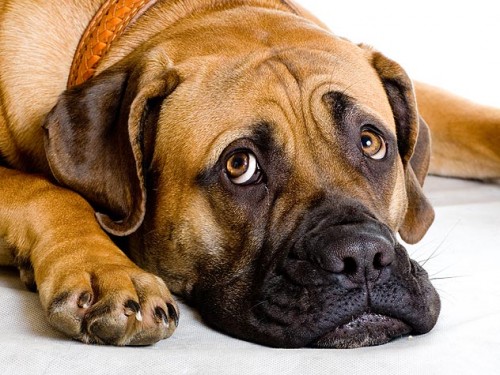
Skunk: If your dog tangles with a skunk, here’s a formula that works for many dog parents:
1 quart 3% hydrogen peroxide
1/4 cup baking soda
1 teaspoon liquid soap
Use the mixture immediately (it cannot be stored in a container), while it’s bubbly, and rinse thoroughly. It may discolor fabric as well as dark colored fur.
Don’t leave the mixture on your dog more than a few minutes. Bathe and condition afterward, if you like.
Dead fish: If you spend time with your dog by a pond, lake, or beach, he may anoint himself from time to time with eau de dead fish.
Wash the worst of it off with dog shampoo and water, and rinse well. Then saturate the fishy area with lemon juice – freshly squeezed works best. Let it soak for five to ten minutes — a nice time to chat with your dog. (Don’t scold him — he’s just doing dog things that you could prevent with a leash.)
Then rinse, shampoo, and rinse again, and apply conditioner according to directions to counteract the drying effect of the lemon juice.
Icky, greasy, who-knows-what gunk: If your dog rolls in foul-smelling things he finds in the yard or on a walk, a bath with Dawn dishwashing liquid will probably remove it. Dawn is often used to clean up wildlife that has been exposed to oil and other toxic substances.
How-to: Hand Stripping and Dog Grooming for a Wire Haired Terrier
How to Give Your Dog a Bath
As much as we all love for our furry friends to smell fresh and clean, getting to that point isn’t always easy. Dogs are rarely excited to jump into the bathtub for a good scrub. Bathing fearful dogs might be better handled by a professional groomer or your veterinary office. But if you decide to wade in, here are some helpful hints.
GETTING (YOU) READY
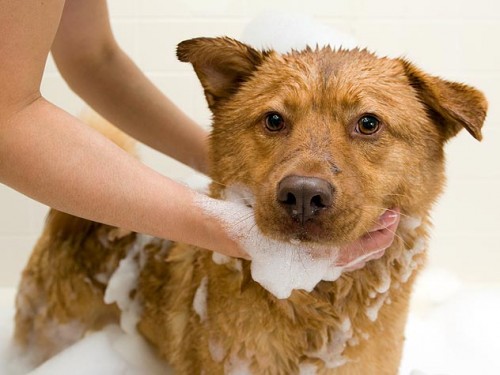
GETTING (FIDO) READY
Trimming your pet’s nails prior to bath time will not only give your dog better footing, it will also help protect your skin in case he tries to make a break for it. Now, bring the dog into the bathroom and close the door behind you — catching a wet, soapy dog running down your hallway is no easy task! Give praise and treats to make him comfortable in the bathroom before you try to get him into the tub. If you’re able to, gently putting a cotton ball in each ear can help keep water out — just be sure to remove them when you’re finished! Also, to help keep shampoo from irritating his eyes, you can put a drop of mineral oil in each one.
BRING ON THE SUDS
Dogs are unlikely to get into the tub willingly. For bigger dogs, a second person to help you get Fido into the bath can help avoid straining your back. Make sure water isn’t too hot or too cold. Let your dog hear and then gently feel the water before going full-speed ahead with the bath. Start shampooing your dog’s shoulders and then move out from there. Be gentle around the face and any sensitive areas but be sure you get down to the undercoat. Read the directions on the shampoo bottle carefully to ensure proper usage. Rinse out all the shampoo, using your fingers to make sure you get through the undercoat to avoid subsequent irritation. This is where a detachable showerhead or bowl comes in handy to be sure bigger dogs get rinsed thoroughly.
NO MORE TANGLES
After the shampoo has been completely rinsed out, you can apply conditioner, if desired. Follow the directions on the bottle because some products need to sit on the coat for several minutes. If you have a particularly squirmy dog, you’ll want to find a fast-acting formula. Once you have finished the bath, it is time to dry your pooch. Towel dry as much as possible in the bathroom. For dogs with longer coats, you may want to use a blow dryer set on low. Before the dog leaves the bathroom, brush his coat out thoroughly because the bath will loosen up a lot of fur, which is better contained in the bathroom than all over the house. Many dogs get “after-bath-crazies,” so hold onto your hat and let ‘em run!
Getting Your Dog Used to Being Groomed
Zookeepers are well aware of the value of husbandry training for their animals. Animals in zoos often need to be weighed, have blood drawn, get their nails clipped, and various other maintenance activities. Gone are the days when animals are anesthetized or pressed into squeeze cages for this work. Now trainers teach the animals to stand quietly while their bodies are handled or medicated. Elephants open their mouths to have their teeth inspected, giraffes stand still on a weigh scale, and dolphins swim up and hold out their fins to have blood taken. How do trainers accomplish this? It’s actually quite simple. The animal is taught to climb on the weigh scale or present its ear for the reward of a treat. The behavior is well established without exposing the animal to any unpleasant experiences. An impressive example is the story of a diabetic baboon living in a California zoo. The baboon needed daily insulin shots but he was so aggressive, he had to be sedated each time. This was taking a toll on his health, because of both the sedative and the chronic stress. The zoo brought in animal trainer Gary Priest to see what could be accomplished. Progressing in very small steps, Gary was able to teach the baboon to extend his arm through the bars of the cage and grasp a bar while a technician applied alcohol to his arm, presented a needle, and applied a quick pinch. Eventually, the baboon was happy to go through the whole routine for his favorite reward. Several times a day, the procedure was repeated and, once a day, the baboon was given his insulin. To ensure the baboon’s continued cooperation, the number of mock injections had to be much greater than the number of real injections.
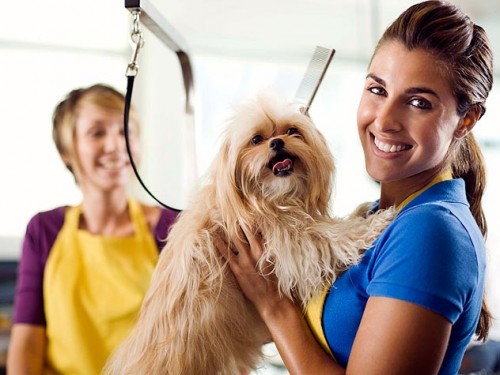
Two or three times a day, play “air” nail clipping. Have your puppy or dog sit and stay. Lift one paw and pretend to clip all the nails but just clip air! Do the same with all four feet. Once a day, clip ONE nail (only if they need it). Intersperse treats throughout. If you do this religiously, your dog will be well mannered and calm during nail clipping. Now, I don’t continue to do this throughout my dog’s life. Once you’ve established a solid foundation, your dog will only need occasional practice.
If your dog is already averse to nail clipping, you’ll have to break the procedure down to miniscule steps. You may have to start by just holding your dog’s paw and touching each nail, with the nail clippers sitting on a nearby table. Treat frequently. Once the dog is comfortable with this, hold the nail clippers in one hand, while holding the dog’s paw with the other. Next, “air clip” only one nail, give an amazing treat, and quit. Resist progressing until the dog is completely comfortable with the step you’re working on. Again, it’s advisable to do this when the dog is sleepy so you’ll meet with less resistance. Be patient – it can take months to reform an intractable nail “clippee”. If all else fails, trot your dog on pavement every day and your nail clipping activities will be restricted to his dewclaws!
Every dog is likely to need medication at some point in his life.
It’s a good idea to accustom your puppy to having his mouth handled so that you can give pills or liquid medicine. For this, I recommend the “baby bird” routine. You’ve probably seen how a baby bird opens its mouth wide to receive a meal from its parent. The baby trusts that food will end up in its mouth. You can teach your puppy to also expect a prize when you open his mouth. Hold the puppy in your lap and place one hand over the top of the puppy’s muzzle. Pry his jaw wide open. With the other hand, pull his bottom jaw down and place a tasty treat on his tongue. Release his mouth. He’ll immediately discover and eat the treat. Make sure you don’t place the treat so far back that the puppy might choke. Repeat numerous times. Pretty soon your puppy will welcome you handling his mouth and, if you occasionally stick a pill inside the treat, your puppy will be unlikely to notice. You may not ever need this training to successfully administer pills but it sure is handy if you have to give liquid medicine or poke around in there to retrieve a chicken bone.
Is there a better way to give pills? Dogs that love food are pretty easy to give pills – just hide the pill in a piece of cheese or wiener and the chowhound is happy to take his medicine. More discriminating dogs chew their food, detect the unwanted pill, and leave it lying on the kitchen floor. For these pill-savvy dogs, here’s a trick that often works. Teach the dog to catch treats tossed to him. Most dogs don’t bother to chew if you get them expecting to catch treats one after the other. On pill days, toss a series of yummy treats, with the pill hidden amongst them. Your dog will never suspect!
Be proactive with your dog. Teach him to enjoy all the things that will inevitably happen to him. He’ll be handled by groomers, poked and prodded by technicians, given needles by veterinarians. You’ll need to check his teeth, inspect his ears and eyes, clip his nails, and give him medication. None of these experiences are naturally pleasant for the dog so teach him to enjoy them. Your dog will be so much easier to care for if you do the foundation work.
How to Trim a Dog’s Nails
When you think about grooming a dog, you probably consider bathing him, brushing his coat, even cleaning those floppy ears, but its a good idea to give dogs a pedicure every few weeks as well. If youve never trimmed a dogs nails, ask for some help from a more experienced person, and keep these instructions nearby.
1: Stay Sharp
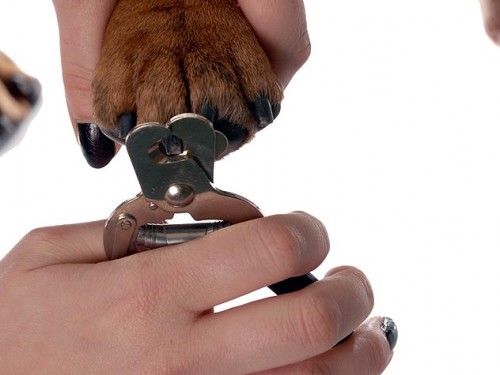
2: Pull Their Legs
Dogs are often pretty cooperative when it comes to having their nails trimmed, and those who were handled often as puppies are even more likely to comply. Still, you may need to work a little to keep the animal still. If youre working alone, have the dog sit or lie down on the floor or examining table, then trim the nails, one paw at a time.
3: Pull Their Legs, Part II
If youre grooming a larger dog or if the animal is apprehensive, have someone sit him down and hold out his paw, then get to work with the clippers. Have your helper scratch behind the dogs ears to reassure the animal and help move things along a little more quickly.
4: Take the Edge Off
Remember that you should only remove the very end of the dogs nails. You may be tempted to trim off all of the excess, but that would be a mistake. In dogs, the quickthe nerve endings and blood vessels inside the nailcontinue to grow as the nail grows. That means long nails must be trimmed bit by bit, over weeks or months, until the quick gradually recedes. Because its so difficult to see the quick in dogs with dark nails, youll need to look at the nail straight on (see diagram below)and keep trimming until you see a small dark circle. If you accidentally clip too far and the nail begins to bleed, apply pressure to the tip of the nail or dip the nail in a bit of styptic powder, then make sure the animal is kept inactive for a short time.
5: Thank Them Very Much
Give the dog a treat or a pat on the tummy to thank him for his cooperation, and things should go at least as well the next time around.
Professional Dental Cleanings
Just as important as providing your pet with food, water and regular physical exams is an annual, professional dental cleaning. Even with good regular at-home care, plaque and tartar build up, making professional cleanings essential. Untreated dental disease can cause significant discomfort and pain as well as permanent loss of teeth and gum tissue. Remember, your pet cannot tell you when he or she is in pain. Pets rely on their owners to take care of them and recognize when something is out of the ordinary.
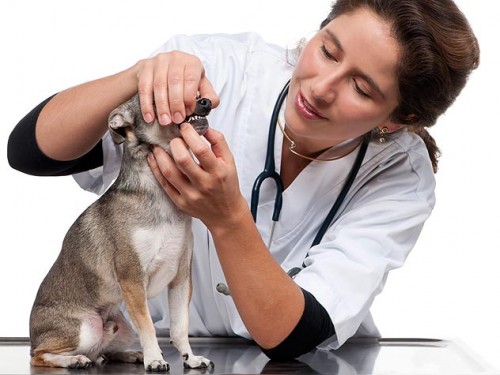
Your veterinarian will run pre-operative bloodwork to make sure your pet is healthy enough to undergo the anesthesia necessary for the procedure. While modern anesthesia is considered very safe, this is a precautionary measure to minimize any risks.
Your veterinarian might take dental radiographs (X-rays) to provide a better evaluation of the health of your pet’s teeth and jaw bone.
During the cleaning, the veterinary team will monitor your pet’s vital signs to ensure that they are normal. These vitals include respiration rate, heart rate, blood oxygen levels and body temperature.
Your pet’s teeth will be cleaned and polished with professional equipment that smoothes the tooth surface, removes tartar and plaque and polishes the teeth.
Antibitoics and/or pain medications may be prescribed depending on the extent of disease at the time of cleaning.
Once the dental cleaning is complete, your pet will be carefully brought out of anesthesia. Your veterinarian will ensure that your pet has recovered properly before releasing him or her to go home. Follow all home care instructions and be sure to check with your veterinarian immediately if you have any concerns.





